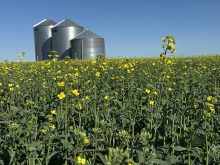After years of gloom, hemp farmers are optimistic again.
With the U.S. market now clear of government harassment, demand for Canadian hemp seed should roar back, many said at the Canadian Hemp Trade Alliance’s annual meeting Oct. 24 in Winnipeg.
“It’s a big opportunity for Canadian farmers,” said hemp grower Kevin Friesen of Laird, Sask., who also operates a hemp clothing company in Vancouver.
“There’s going to be demand again.”
Sales of Canadian hemp seed to the United States collapsed after the Drug Enforcement Administration tried to ban hemp food products in October 2001.
Read Also

Huge Black Sea flax crop to provide stiff competition
Russia and Kazakhstan harvested huge flax crops and will be providing stiff competition in China and the EU.
Hemp food producers obtained court injunctions against the drug agency rules, but many major food processors shied away from hemp because they didn’t want to get caught with banned food in their warehouses.
In February, the U.S. ninth circuit court of appeals upheld a lower court decision that ruled hemp should be treated like a normal food product and not be controlled by the DEA. The DEA announced in October that it would not appeal that decision.
The DEA wanted agricultural hemp banned because trace amounts of THC in edible hemp could create false positives in urine and blood tests regularly demanded by many American employers. THC is the primary drug in marijuana.
The hemp industry argued that the THC traces were so small that they could never be confused with marijuana use, and eventually the courts agreed.
The DEA’s decision to not appeal the court’s decision ended the most recent battle over the legal sale of hemp food products in the U.S.
That had “Mr. Hemp,” Don Wirtshafter of Athens, Ohio, encouraging farmers at the convention to get back on board the hemp train.
“The border is open and the hesitancy of the large industries to put hemp in the products is now over,” said Wirtshafter in an interview.
“Our only problem now is that we wish we had four times the product in Canada, because we could sell it this winter.”
Hemp production boomed in some parts of the Prairies, such as the Dauphin, Man., area, after the Canadian government legalized hemp production in 1998. Some farmers planted more than a section each of hemp, producing huge amounts of seed and fibre.
But when the biggest contractor in the Canadian industry, Consolidated Growers and Processors, went bankrupt, many of the biggest producers were left with no contracts and nowhere to sell their product. With the DEA strangling demand in the U.S., many farmers ended up sitting on bins of hemp seed for years.
A lot was sold as bird feed and now that those stocks have been slowly consumed, hemp users are short of supply. This summer’s crop was hurt by cool growing conditions and the few remaining producers produced little.
“Everything’s gone. Anything that was produced by farmers has been sold already,” said Wirtshafter. “If it’s not, they should bring it to Hemp Oil Canada, because we want it.”
Wirtshafter is encouraging Canadian farmers to plant big next spring.
“Now that the handcuffs have been taken off us … next year Canadian growers are going to have to greatly increase their plantings to keep up with demand,” he said.
Dauphin farmer Jim Mulligan was happy to hear that the hemp industry has come out of its slump.
“This industry is going to grow. I know it is,” said Mulligan.
He didn’t grow any hemp this summer because of bad market conditions. He thinks his area needs a hemp fibre plant before production takes off again, but said there is a big base of producers ready to get back into hemp as soon as seed and fibre buyers prove there’s real demand.
“If we had a plant in place, I’d do a lot of acres,” said Mulligan.
Friesen has had to face both bad market conditions and poor growing conditions on his farm in Saskatchewan.
This summer he got a good crop of 900 pounds per acre, a welcome reprieve from the drought years.
“It’s hard to grow a crop with two inches of rain,” he said.

















